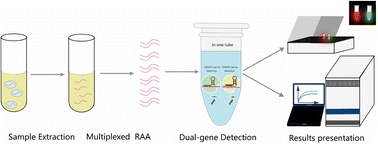Rapid detection of HPV16/18 based on a CRISPR-Cas13a/Cas12a dual-channel system†
Abstract
Purpose: cervical cancer is the leading cause of cancer deaths in women in the developing world, with high-risk HPV16 and HPV18 accounting for approximately 70% of all cervical cancers. Early detection of HPV, especially high-risk HPV types, is essential to prevent disease progression. Methods: in this study, we established a highly sensitive and specific nucleic acid assay based on a CRISPR-Cas13a/Cas12a dual-channel system combined with multiplex RAA for rapid detection and typing of HPV16/18, which provides a new idea for cervical cancer screening. To meet the application of field testing, we designed a portable fluorescence imaging assay that can judge the test results directly with the naked eye or through cell phone imaging. Results: the lower limit of detection for both HPV16 and HPV18 based on the CRISPR-Cas12a/Cas13a dual-channel assay was 100 copies per μL. The dual-channel assay was validated with 55 clinical samples, showing 97.06% sensitivity, 100% specificity, 100% positive predictive value, and 96.55% negative predictive value. The results of the portable fluorescence imaging assay were fully comparable to those of the real-time fluorescent RAA-based CRISPR-Cas12a/Cas13a dual-channel assay. Conclusions: this developed portable dual gene assay platform may provide new technical support for cervical cancer screening in resource-limited settings.



 Please wait while we load your content...
Please wait while we load your content...